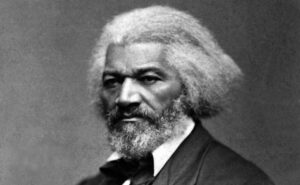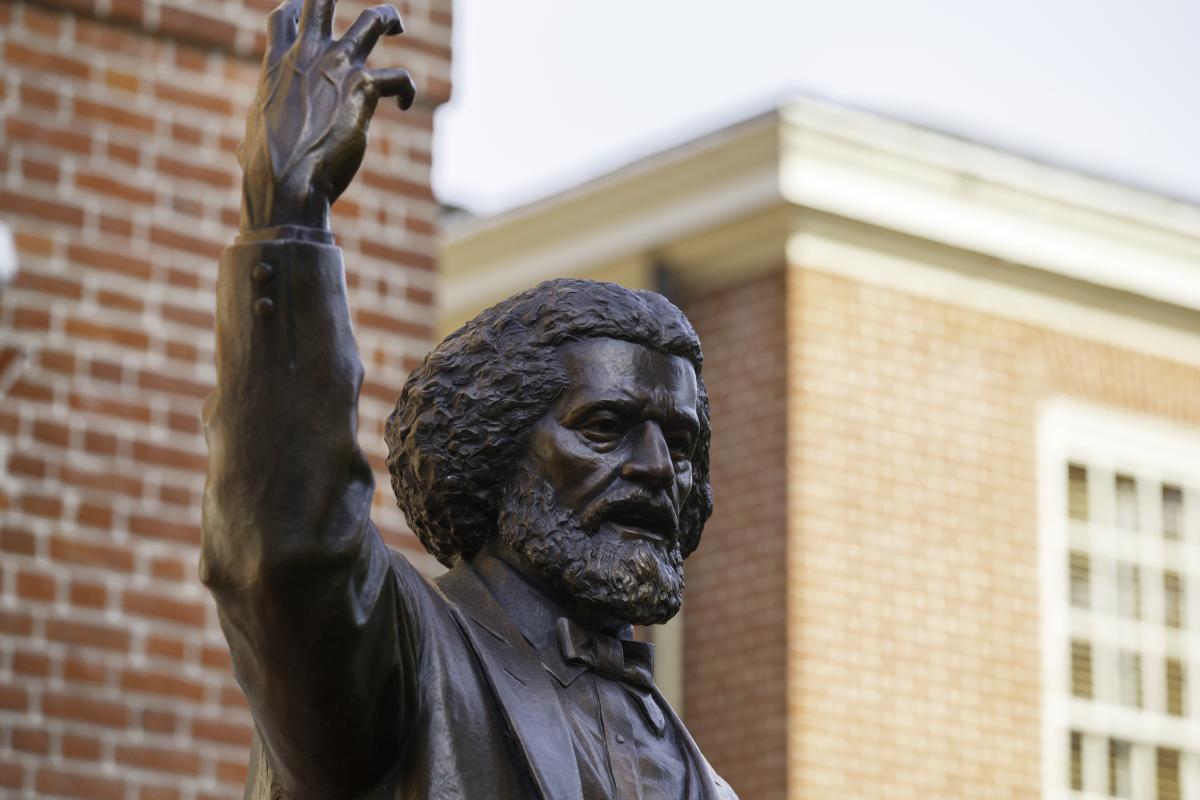As Talbot County again debates the propriety of maintaining a statue on the grounds of the county courthouse to soldiers who fought for the Confederate States of America, it may be illustrative to read the words of Frederick Douglass concerning the cause of the war and whether rebel soldiers deserved the same honors as Union veterans and war dead.
Douglass, arguably the greatest native of Talbot County, was born a slave and escaped north to became a world-renowned orator and statesman and a leading abolitionist.
In speeches during and after the Civil War, Douglass made it clear that slavery was the reason for the rebellion of southern states against the United States of America.
In a lecture delivered repeatedly in the winter of 1863-1864, Douglass said:
“We are now wading into the third year of conflict with a fierce and sanguinary rebellion, one which, at the beginning of it, we were hopefully assured by one of our most sagacious and trusted political prophets would be ended in less than ninety days; a rebellion which, in its worst features, stands alone among rebellions a solitary and ghastly horror, without a parallel in the history of any nation, ancient or modern; a rebellion inspired by no love of liberty and by no hatred of oppression, as most other rebellions have been, and therefore utterly indefensible upon any moral or social grounds; a rebellion which openly and shamelessly sets at defiance the world’s judgment of right and wrong, appeals from light to darkness, from intelligence to ignorance, from the ever-increasing prospects and blessings of a high and glorious civilization to the cold and withering blasts of a naked barbarism; a rebellion which even at this unfinished stage of it counts the number of its slain not by thousands nor by tens of thousands, but by hundreds of thousands; a rebellion which in the destruction of human life and property has rivaled the earthquake, the whirlwind and the pestilence that waketh in darkness and wasteth at noonday.
It has planted agony at a million hearthstones, thronged our streets with the weeds of mourning, filled our land with mere stumps of men, ridged our soil with two hundred thousand rudely formed graves and mantled it all over with the shadow of death. A rebellion which, while it has arrested the wheels of peaceful industry and checked the flow of commerce, has piled up a debt heavier than a mountain of gold to weigh down the necks of our children’s children. There is no end to the mischief wrought. It has brought ruin at home, contempt abroad, has cooled our friends, heated our enemies and endangered our existence as nation.

Frederick Douglass
“Now, for what is all this desolation, ruin, shame suffering and sorrow? Can anybody want the answer? Can anybody be ignorant of the answer? It has been given a thousand times from this and other platforms. We all know it is slavery. Less than a half a million of Southern slaveholders — holding in bondage four million slaves — finding themselves outvoted in the effort to get possession of the United States government, in order to serve the interests of slavery, have madly resorted to the sword — have undertaken to accomplish by bullets what they failed to accomplish by ballots. That is the answer.”
— From www.blackpast.org/african-american-history/1864-frederick-douglass-mission-war
During the Decoration Day ceremony on May 30, 1871, at Arlington National Cemetery, Douglass continued to remind the nation that the war had been fought over slavery. He also made clear his thoughts that rebel soldiers — who had fought for slavery — should not receive the same honors as Union soldiers — who had fought for their nation and for liberty and justice.
Honoring the “Unknown Loyal Dead” buried at the cemetery, Douglass said:
Those unknown heroes whose whitened bones have been piously gathered here, and whose green graves we now strew with sweet and beautiful flowers, choice emblems alike of pure hearts and brave spirits, reached, in their glorious career that last highest point of nobleness beyond which human power cannot go. They died for their country.
No loftier tribute can be paid to the most illustrious of all the benefactors of mankind than we pay to these unrecognized soldiers when we write above their graves this shining epitaph.
When the dark and vengeful spirit of slavery, always ambitious, preferring to rule in hell than to serve in heaven, fired the Southern heart and stirred all the malign elements of discord, when our great Republic, the hope of freedom and self-government throughout the world, had reached the point of supreme peril, when the Union of these states was torn and rent asunder at the center, and the armies of a gigantic rebellion came forth with broad blades and bloody hands to destroy the very foundations of American society, the unknown braves who flung themselves into the yawning chasm, where cannon roared and bullets whistled, fought and fell. They died for their country.
We are sometimes asked, in the name of patriotism, to forget the merits of this fearful struggle, and to remember with equal admiration those who struck at the nation’s life and those who struck to save it, those who fought for slavery and those who fought for liberty and justice.
I am no minister of malice. I would not strike the fallen. I would not repel the repentant; but may my “right hand forget her cunning and my tongue cleave to the roof of my mouth,” if I forget the difference between the parties to that terrible, protracted, and bloody conflict.
If we ought to forget a war which has filled our land with widows and orphans; which has made stumps of men of the very flower of our youth; which has sent them on the journey of life armless, legless, maimed and mutilated; which has piled up a debt heavier than a mountain of gold, swept uncounted thousands of men into bloody graves and planted agony at a million hearthstones — I say, if this war is to be forgotten, I ask, in the name of all things sacred, what shall men remember?
The essence and significance of our devotions here to-day are not to be found in the fact that the men whose remains fill these graves were brave in battle. If we met simply to show our sense of bravery, we should find enough on both sides to kindle admiration. In the raging storm of fire and blood, in the fierce torrent of shot and shell, of sword and bayonet, whether on foot or on horse, unflinching courage marked the rebel not less than the loyal soldier.
But we are not here to applaud manly courage, save as it has been displayed in a noble cause. We must never forget that victory to the rebellion meant death to the republic. We must never forget that the loyal soldiers who rest beneath this sod flung themselves between the nation and the nation’s destroyers. If today we have a country not boiling in an agony of blood, like France, if now we have a united country, no longer cursed by the hell-black system of human bondage, if the American name is no longer a by-word and a hissing to a mocking earth, if the star-spangled banner floats only over free American citizens in every quarter of the land, and our country has before it a long and glorious career of justice, liberty, and civilization, we are indebted to the unselfish devotion of the noble army who rest in these honored graves all around us.
— Text of Douglass speech from Philip S. Foner and Yuval Taylor, “Frederick Douglass: Selected Speeches and Writings.”
Douglass also warned of the “Lost Cause” mythology developed after the war that the rebels had been fighting for states’ rights, not to preserve slavery. And he challenged the laudatory obituaries about General Robert E. Lee in 1870 and opposed any monuments honoring Lee or supporting the Lost Cause interpretation.
In 1989, historian David Blight wrote this about Douglass:
In the midst of Reconstruction, Douglass began to realize the potential power of the Lost Cause sentiment. Indignant at the universal amnesty afforded ex-Confederates, and appalled by the national veneration of Robert E. Lee, Douglass attacked the emerging Lost Cause.
“The spirit of secession is stronger today than ever …,” Douglass warned in 1871. “It is now a deeply rooted, devoutly cherished sentiment, inseparably identified with the ‘lost cause,’ which the half measures of the Government towards the traitors have helped to cultivate and strengthen.”
He was disgusted by the outpouring of admiration for Lee in the wake of the general’s death in 1870.
“Is it not about time that this bombastic laudation of the rebel chief should cease?” Douglass wrote. “We can scarcely take up a newspaper . . . that is not filled with nauseating flatteries of the late Robert E. Lee.”
At this early stage in the debate over the memory of the war, Douglass had no interest in honoring the former enemy.
“It would seem from this,” he asserted, “that the soldier who kills the most men in battle, even in a bad cause, is the greatest Christian, and entitled to the highest place in heaven.” …
As for proposed monuments to Lee, Douglass considered them an insult to his people and to the Union. He feared that such monument building would only “reawaken the confederacy.”
Moreover, in a remark that would prove more ironic with time, Douglass declared in 1870 that “monuments to the Lost Cause will prove monuments of folly.”
As the Lost Cause myth sank deeper into southern and national consciousness, Douglass would find that he was losing ground in the battle for the memory of the Civil War.
— Taken from https://blogs.dickinson.edu/hist-288pinsker/files/2012/01/Blight-article.pdf
In 1894, in one of his last public speeches, Douglass continued to make the case that the American public should not forget that the rebels fought to preserve slavery and waged war against the nation.
“Fellow citizens: I am not indifferent to the claims of a generous forgetfulness, but whatever else I may forget, I shall never forget the difference between those who fought for liberty and those who fought for slavery; between those who fought to save the Republic and those who fought to destroy it.”
Among those debating the issue today, some still continue to believe that a major cause of the war was states’ rights, and not slavery. This view was expounded by Southerners after their decisive loss as part of the “Lost Cause” mythology of the war that included a romanticized view of the Old South and slavery itself. (For a synopsis of the Lost Cause ideology, see en.wikipedia.org/wiki/Lost_Cause_of_the_Confederacy#:~:text=The%20Lost%20Cause%20narratives%20typically,superior%20military%20skill%20and%20courage)
Among those spreading the revised narrative after the war was Alexander Stephens, the vice president of the Confederate States of America.
Yet Stephens — just a few weeks before rebel troops started the war by firing on American soldiers at Fort Sumter in Charleston Harbor, S.C. — made it absolutely clear that he agreed with Douglass: The cause of the war was slavery and the Confederate states were founded on the idea of white supremacy.
In what became known as the Cornerstone Speech, Stephens — after highlighting what he cited as several improvements in the Confederate constitution over the U.S. Constitution — said:
The new constitution has put at rest, forever, all the agitating questions relating to our peculiar institution — African slavery as it exists amongst us — the proper status of the negro in our form of civilization. This was the immediate cause of the late rupture and present revolution. Jefferson in his forecast, had anticipated this, as the “rock upon which the old Union would split.” He was right. What was conjecture with him, is now a realized fact. But whether he fully comprehended the great truth upon which that rock stood and stands, may be doubted. The prevailing ideas entertained by him and most of the leading statesmen at the time of the formation of the old constitution, were that the enslavement of the African was in violation of the laws of nature; that it was wrong in principle, socially, morally, and politically. It was an evil they knew not well how to deal with, but the general opinion of the men of that day was that, somehow or other in the order of Providence, the institution would be evanescent and pass away. This idea, though not incorporated in the constitution, was the prevailing idea at that time. The constitution, it is true, secured every essential guarantee to the institution while it should last, and hence no argument can be justly urged against the constitutional guarantees thus secured, because of the common sentiment of the day. Those ideas, however, were fundamentally wrong. They rested upon the assumption of the equality of races. This was an error. It was a sandy foundation, and the government built upon it fell when the “storm came and the wind blew.”
Our new government is founded upon exactly the opposite idea; its foundations are laid, its corner-stone rests upon the great truth, that the negro is not equal to the white man; that slavery — subordination to the superior race — is his natural and normal condition. [Applause.] This, our new government, is the first, in the history of the world, based upon this great physical, philosophical, and moral truth.
— Excerpt from https://www.owleyes.org/text/the-cornerstone-speech/read/text-of-stephenss-speech#root-38




